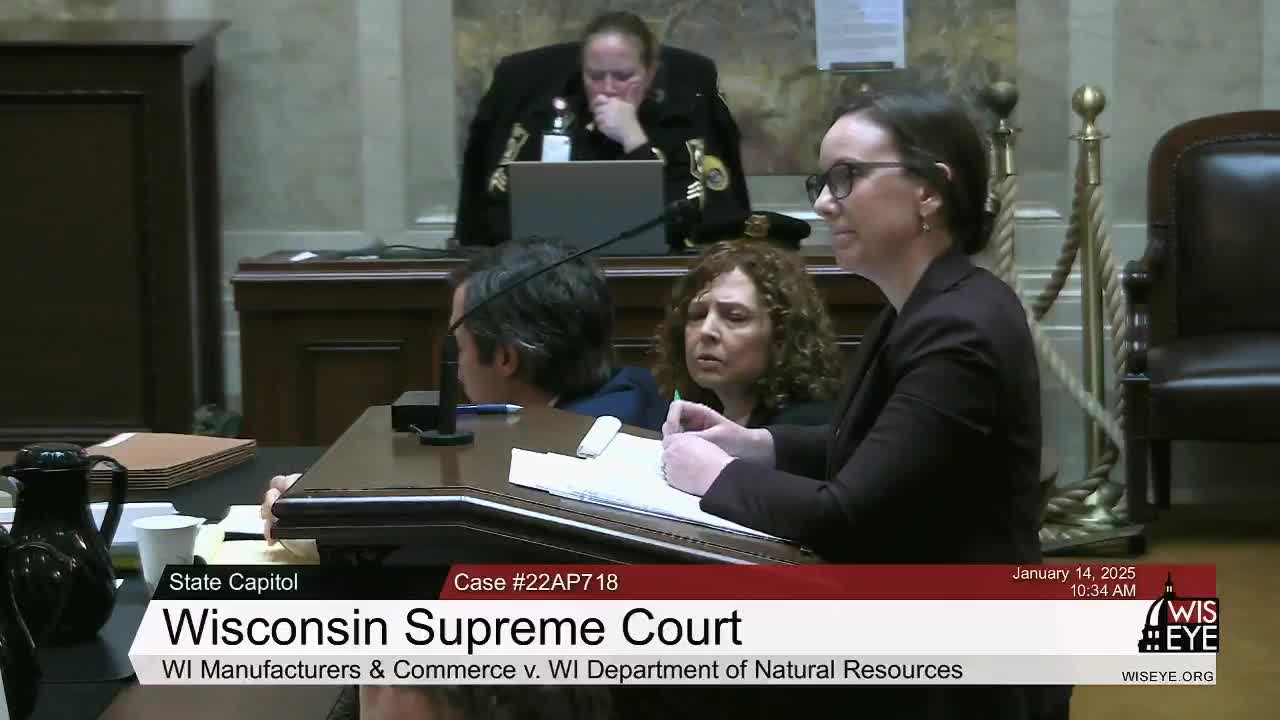Court debates classification of PFAS as hazardous amid scientific disputes over health risks
January 14, 2025 | Supreme Court Rulings , Judicial, Wisconsin
This article was created by AI summarizing key points discussed. AI makes mistakes, so for full details and context, please refer to the video of the full meeting. Please report any errors so we can fix them. Report an error »

In a pivotal session on January 14, 2025, the Wisconsin Supreme Court convened to deliberate the case of Wisconsin Manufacturers and Commerce, Inc. v. Wisconsin Department of Natural Resources, focusing on the contentious issue of PFAS—per- and polyfluoroalkyl substances—an emerging environmental concern. The courtroom buzzed with tension as attorneys presented their arguments regarding the classification and regulation of these substances, which have been linked to serious health risks.
The discussion centered on the classification of PFAS as hazardous substances. With over 9,000 known PFAS compounds, the debate highlighted the complexities of regulating such a broad category. One attorney argued that while certain PFAS compounds pose significant dangers, the science surrounding all 9,000 is still developing, leading to disagreements on their classification. This uncertainty raises questions about the implications for businesses and the environment, as the attorney emphasized that not all PFAS are hazardous.
The court heard that PFAS do not break down in the environment, remaining in air and water for extended periods. This persistence has led to increased scrutiny and calls for stricter regulations. The attorney representing the Department of Natural Resources pointed out that scientific studies have linked PFAS exposure to various health issues, including thyroid disease, cancer, and reproductive problems. However, the opposing counsel contested the blanket categorization of PFAS as hazardous, arguing that the scientific evidence does not support such a broad classification.
As the justices probed deeper, they sought clarity on the implications of their ruling. If the court sided with the manufacturers, it could mean that responsible parties would not be required to report PFAS discharges until specific regulations are established. This raised concerns about potential environmental impacts and public health risks, as the attorney for the DNR noted that existing spill laws could still apply to certain PFAS discharges.
The session underscored the ongoing struggle between regulatory bodies and industries over environmental protections. As the justices weighed the arguments, the outcome of this case could set a significant precedent for how Wisconsin addresses the growing challenge of PFAS contamination. With public health and environmental safety hanging in the balance, the court's decision will likely resonate far beyond the courtroom, shaping the future of environmental policy in the state.
The discussion centered on the classification of PFAS as hazardous substances. With over 9,000 known PFAS compounds, the debate highlighted the complexities of regulating such a broad category. One attorney argued that while certain PFAS compounds pose significant dangers, the science surrounding all 9,000 is still developing, leading to disagreements on their classification. This uncertainty raises questions about the implications for businesses and the environment, as the attorney emphasized that not all PFAS are hazardous.
The court heard that PFAS do not break down in the environment, remaining in air and water for extended periods. This persistence has led to increased scrutiny and calls for stricter regulations. The attorney representing the Department of Natural Resources pointed out that scientific studies have linked PFAS exposure to various health issues, including thyroid disease, cancer, and reproductive problems. However, the opposing counsel contested the blanket categorization of PFAS as hazardous, arguing that the scientific evidence does not support such a broad classification.
As the justices probed deeper, they sought clarity on the implications of their ruling. If the court sided with the manufacturers, it could mean that responsible parties would not be required to report PFAS discharges until specific regulations are established. This raised concerns about potential environmental impacts and public health risks, as the attorney for the DNR noted that existing spill laws could still apply to certain PFAS discharges.
The session underscored the ongoing struggle between regulatory bodies and industries over environmental protections. As the justices weighed the arguments, the outcome of this case could set a significant precedent for how Wisconsin addresses the growing challenge of PFAS contamination. With public health and environmental safety hanging in the balance, the court's decision will likely resonate far beyond the courtroom, shaping the future of environmental policy in the state.
View full meeting
This article is based on a recent meeting—watch the full video and explore the complete transcript for deeper insights into the discussion.
View full meeting
